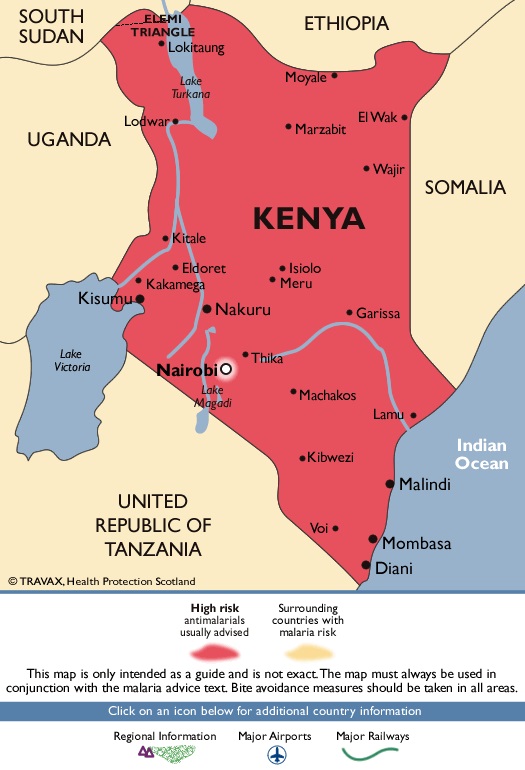Kenya
Official Name Republic of KenyaTotal area 580,367 sq km
Population 44,037,656 (July 2013 est.)
Capital City Nairobi
Map

Background
Kenya is a sovereign state in East Africa. It is located on the equator and is bordered by the Indian Ocean, Tanzania, Uganda, South Sudan, Ethiopia and Somalia. The country is named after Mount Kenya, the second highest mountain in Africa.
From 1969 until 1982, Kenya was a one-party state. In August 2010, Kenyans overwhelmingly adopted a new constitution in a national referendum.
Economy
Kenya’s economy has been hindered by corruption, as well as dependence on several primary goods whose prices have remained low. Low infrastructure investment threatens Kenya’s long-term position as the largest East African economy. In 2006, loans by the World Bank and IMF were delayed, awaiting action by the Kenyan government on corruption.
Unemployment is high, and the country has gone through protracted budget shortfalls, inflationary pressures, as well as severe currency depreciation due to high food and fuel import prices. An opportunity for balancing trade deficit can be found in the discovery of oil in March 2012 if deposits are commercially viable, and a port and pipeline are developed for oil exportation.
Health
While Kenya has had significant accomplishments in the health division, the country still faces many challenges. Life expectancy estimates have dropped to around 55 years in recent years, which is five years below 1990 levels.
80% of the population who visit health centres and private clinics in rural and under-served urban areas are treated by nurses, while complex cases are referred to clinical or medical officers and specialists.
In 2011, the Kenya National Bureau of Statistics disclosed that there were 65,000 qualified nurses, 8,600 clinical officers and 7,000 doctors for the population of 43 million people registered in the country. These statistics include those who have died or left the profession, thus, the actual numbers may be lower.
Approximately 50% of Kenyans live below the poverty line, constantly at risk of preventable diseases like malaria, HIV/AIDS, pneumonia, and malnutrition. They are the largest health burden, main child-killers and are accountable for much morbidity due to weak policies, corruption, inadequate health workers, poor management in the public health sector.
Major infectious diseases:
Food or waterborne diseases: bacterial and protozoal diarrhea, hepatitis A, and typhoid fever
Vectorborne disease: malaria and Rift Valley fever
Water contact: schistosomiasis
Malaria Status
Malaria is one of the chief causes of morbidity and mortality in Kenya. 77% of Kenya’s population lives in areas where the disease is transmitted and is at risk of malaria.
Malaria is accountable for 30% of out-patient visits and 15% of all hospital admissions. Kenya’s Ministry of Health estimated that 170 million working days are lost annually due to malaria
The most vulnerable groups to malaria infections are pregnant women and children under 5 years of age. It is also estimated to cause 20% of all deaths in children under five. During pregnancy, malaria can cause miscarriages and anemia. Each year, around 6,000 pregnant women suffer from anemia related to malaria, and 4,000 babies are born with low birth weight as a result of it.
The epidemiology of the disease is fairly diverse geographically. High levels of transmission occur on the coast and around Lake Victoria, with little to no transmission in highlands located above 1,500–2,000 meters altitude.
Recent household surveys have shown important progress made against malaria in Kenya, as the Kenyan government adjusts its malaria control plans and efforts according to malaria risk in order to realize maximum impact. There have been improvements in coverage and malaria prevention and treatment measures, especially with the use of insecticide-treated nets (ITNs) by communities at risk.
SEARCH
TESTIMONIALS
-
The African Development Bank is pleased to invite you to a presentation from InRaD (Innovative Research and Development Corporation) on their latest innovation to fight m ...Egyptian Innovation: A Green Cure for Malaria
-
Field trail using Sunlight activated Formulated Extract (SAFE) to target and control Mosquito larvae (The Vector of malaria and filarial diseases); Novel Egyptian Technology for mosquito control.Sudan Testimonial
-
In this regard, Her Excellency would like to express her appreciation for your endeavors, which contribute in developing the relations with the Nile basin countries speci ..."H.E." Fayza Abu El Naga
-
On behalf of the Government conclusion, I find the Egyptian extract extremely efficient in killing mosquito larvae which can ingest particles of this extract and its stri ...Uganda Virus Research Institution
-
Earlier this morning, we had a very good meeting with two of our compatriots, Dr. Walid A. Ali and Dr. Tarek A. El Tayeb of the innovative Research and Development (INRad ...Federal Democratic Republic of Ethiopia Ministry of Health
